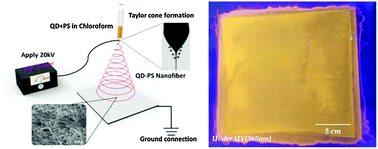CuInS2/ZnS quantum dot-embedded polymer nanofibers for color conversion films†
Abstract
Color-conversion films (CCFs) were fabricated with CuInS2/ZnS quantum dot (QD)-embedded polymer nanofibers and applied for white color emission with blue light-emitting diodes (LEDs). Red-orange color emitting CuInS2/ZnS QDs were synthesized and a photoluminescence quantum yield (PL QY) of 75% was achieved by controlling the Cu : In ratio in the QDs as well as the ZnS shell thickness. QD-embedded polystyrene nanofibers were electrospun on conducting aluminium substrates. The QD-embedded nanofiber (QDEN) structure is believed to reduce the aggregation of the QDs compared to that in a thin-film polymer. Time-resolved photoluminescence (TRPL) analysis showed a longer PL lifetime (138 ns) with the QDEN film than with a mould-cast thin film (45 ns). The longer PL lifetime with the QDEN structure is attributed to decreased quenching due to reduced aggregation. For the white lighting device, the QDEN films were applied as CCFs on a light guide plate (4.3 inch) with a GaN blue LED source. The resulting device demonstrated increased efficiency (from 11.5 to 32.3 lm W−1) and color rendering index values (from 71 to 91) compared to commercial white LEDs. These Cd-free QD-embedded nanofiber films are expected to provide efficient and safe solutions for large-area processing of lighting devices.


 Please wait while we load your content...
Please wait while we load your content...